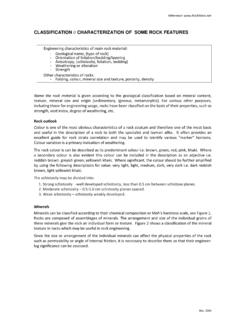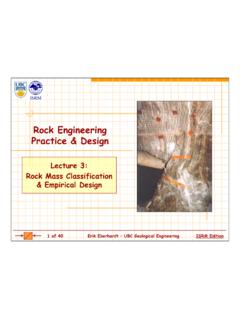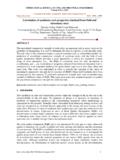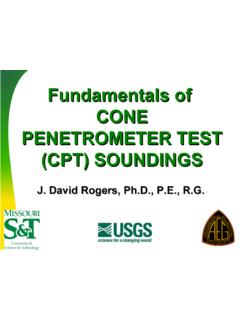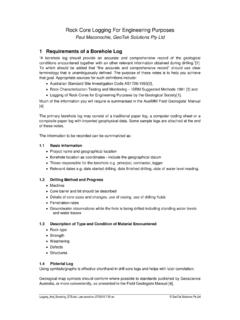Transcription of Rock Mass Strength Gibson Rev 2 - SRK
1 Rock mass Strength derived from Rock mass characterization Gibson , W H, SRK Consulting, Perth, Western Australia, Australia Updated version of the paper published in the Journal of Australian Geomechanics Vol 41 No March 2006 ABSTRACT: The assessment of rock mass Strength is a key element for the analysis of many rock excavations, both open pit and underground. There have been attempts to assess this Strength using a suitable rock mass Strength criterion having input derived using a Rock mass Classification system., The most well developed criterion is the Hoek-Brown Failure Criteria using the Geotechnical Strength Index (Hoek, 2002) as input. Despite its popularity, the GSI has some inconsistencies. Rock masses with differing fracture frequencies and joint conditions can have the same GSI value and therefore the same Strength characteristics would be applied.
2 To address this issue, this paper describes a method to determine the input to the criterion on the basis of the joint condition and fracturing of the rock mass . 1 INTRODUCTION The assessment of rock mass Strength is a key element in any rock excavation for both, open pit and underground excavations. When numerical models are used as a tool of analysis, this Strength is defined in terms of a Strength envelope. The envelope may be linear, like Mohr Coulomb or non linear like that suggested by Hoek [1995]. There are empirical methods that relate rock mass classifications with design parameters like slope angles, open-spans and support, Bieniawski [1989], Laubscher [1990], Barton [1974]. The classification methods do not however directly provide the Strength The non-linear Hoek Brown criterion relates the Strength envelope to the rock mass classification through the GSI index.
3 This method allows Strength assessment based on actual data collected on site, mainly discontinuity density, discontinuity condition, plus laboratory information like unconfined compressive Strength . One drawback of this method is that different characteristics of the rock mass , like joint condition and discontinuity density, are combined in a single number, GSI, and this number is used to assess the rock mass Strength . Two different rock masses can have the same GSI (Figure 1) but if the joint condition and discontinuity density are different, it is unlikely that both rock masses would have the same Strength . If the joint condition and discontinuity density are considered separately it is possible to estimate the rock mass Strength for each one. 2 ROCK mass Strength ASSESSMENT BASED ON ROCK mass RATING GSI The rock mass Strength can be evaluated using the Hoek Brown failure criteria [Hoek, 1995].
4 The Strength envelope written in term of the principal stresses is shown in Eq. (1). acibcicism ++= 331 (1) Where ci is the unconfined compressive Strength of the intact rock (UCS), and the parameters mb, s and a are related with the rock mass rating through the GSI. These relationships are shown in Eq (2), (3) and (4). Figure 1: Correlation between GSI and rock mass properties and Nf and Nc parameters definition. Rocscience [8] =DGSI mmib1428100exp (2) =DGSIs39100exp (3) ()3/2015/6121 +=eeaGSI (4) where mi is a material constant and D is a Disturbance Factor.
5 A correlation between the GSI index and the rock mass quality can be seen in Figure 1. 3 ROCK mass Strength ASSESSMENT BASED ON JOINT SPACING AND JOINT CONDITIONS The GSI is insensitive to those rock mass characteristics that most influence rock mass Strength . A series of relationships are proposed that seek to partially address this issue by differentiating rock masses having the same GSI. These relationships are functions of two parameters, Nf and Nc. Nf is a function of the characteristics of the fracturing and interlocking and Nc is a function of the joint condition. The variation of these parameters is conceptually shown in Figure 1, For example a blocky rock with fair joint surface condition might have a GSI=35, in this case the blocky conditions is characterized by the parameter Nf and the fair surface condition by the parameter Nc, The recommended Strength envelope in Eq.
6 (1), uses the same mi parameter as currently used in the Hoek Brown failure criterion however it is proposed that mb, s and a are calculated using the following relationships. () ()()()[]fcffccibNfNNfNfNNmm2max21max1+ = (5) () ()()()[]fcffccNfNNfNfNNs4max43max1+ = (6) ()()[] * * +=fNa (7) The functions fi(Nf) and the parameter Ncmax are functions of the Rock mass Classification system used. The functions fi(Nf) used in Eq. (5) and (6) can be written using the generic form shown in Eq. (8) [])exp()(exp()()(CMNMCABAN fffi += (8) The parameters A, B, C and M used on each function fi(Nf) are shown in Table 1.)
7 Table 1: Parameters A,B,C and M Function i A B C M 1 40 2 40 3 4e-3 40 4 4e-4 40 It is recommended that the standard rock mass classification systems are used to evaluate the parameters Nf and Nc. It is not therefore necessary to obtain any additional data to that currently required as input to these systems. The ratings for spacing of discontinuities and joint condition should be used to evaluate the parameters Nf and Nc. It is important to note this paper do not recommend to use GSI directly to evaluate the rock mass Strength .
8 In this paper, two systems are recommended to be used with the Eq. (5), (6) and (7), Bieniawski [1989], and Laubscher [1990]. Figure 2: Estimation of constants mb/mi and s The parameters mb/mi and s are related to changes in fracture frequency and joint condition. Hoek [1995] presented the indicative values for these parameters shown in Figure 2 .The values of A, B and C in Table 1 were based on the values mb/mi shown in this figure Function 1 describes the changes in mb/mi with changes in the fracture frequency for VERY GOOD surface condition. The maximum and minimum values for mb/mi are and shown in Fig. 2. These values were extrapolated to and , considering Fig 1 has 6 degrees of fracturing and Fig. 2 shows only 4 Function 2 describes the changes in mb/mi with changes in the fracturing for VERY POOR surface condition.
9 The maximum and minimum values for mb/mi are and The value of was increased to because if the number of joints is small the joint condition become less important because there is a few or no joint in any given block of rock mass . For this reason the ratio mb/mi must increase and become slightly lower than the ratio mb/mi for massive rock with a few joints with good surface condition. The minimum value of was kept the same. Function 3 describes the changes that occur to the value of s with changes in the fracture frequency for VERY GOOD surface conditions. The maximum and minimum values for s are and as indicated in Figure 2. The maximum value was increased to to consider those rock masses having very few joints as shown in Figure 1 for massive rock and very good surface conditions.
10 The minimum value of was kept the same. Function 4 describes the changes in s with changes in the fracturing for VERY POOR surface condition. The maximum and minimum values for s are and as indicated in Figure 2. These values where kept without modification. Parameter a. In the Hoek Brown failure criterion the parameter a varies between to for intact rock to poor quality rock. In this paper it is proposed to use Eq. (7) that allows the parameter to vary between to with changes in Nf. Those numbers were based on the non linear Strength envelope of highly fractured rock like rockfill that has an a parameter between to Indraratna [1993]. ROCK mass Strength BASED ON BIENIAWSKI S ROCK mass RATING SYSTEM RMRB The basic parameters used in Bieniawski s Rock mass Rating (RMRB) system are: Strength of Intact Rock ci Drill Core Quality RQD Spacing of discontinuity Condition of Discontinuities (based on discontinuity length, aperture width, roughness, infill type and thickness of the weathering) Ground Water If RMRB is used as a Rock mass Classification system, the Nf and Nc parameters must be calculated using Eq.
